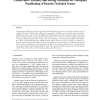Free Online Productivity Tools
i2Speak
i2Symbol
i2OCR
iTex2Img
iWeb2Print
iWeb2Shot
i2Type
iPdf2Split
iPdf2Merge
i2Bopomofo
i2Arabic
i2Style
i2Image
i2PDF
iLatex2Rtf
Sci2ools
COMPGEOM
1998
ACM
1998
ACM
Viewspace Partitioning of Densely Occluded Scenes
Computing the visibility of out-door scenes is often much harder than of in-door scenes. A typical urban scene, for example, is densely occluded, and it is effective to precompute its visibility space, since from a given point only a small fraction of the scene is visible. The difficulty is that although the majority of objects are hidden, some parts might be visible at a distance in an arbitrary location, and it is not clear how to detect them quickly. In this paper we presenta method to partition the viewspace into cells containing a conservative supersetof the visible objects. For a given cell the method tests the visibility of all the objects in the scene. For each object it searches for a strong occluder which guarantees that the object is not visible from any point within the cell. We show analytically that in a densely occluded scene, the vast majority of objects are strongly occluded, and the overhead of using conservative visibility (rather than visibility) is small. These r...
| Added | 05 Aug 2010 |
| Updated | 05 Aug 2010 |
| Type | Conference |
| Year | 1998 |
| Where | COMPGEOM |
| Authors | Yiorgos Chrysanthou, Daniel Cohen-Or, Eyal Zadicario |
Comments (0)

